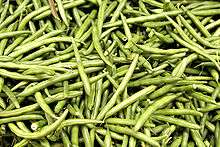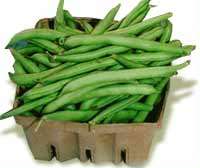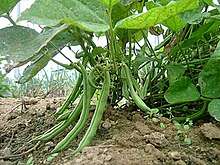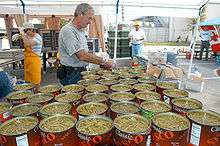Green bean
Green beans are the unripe, young fruit and protective pods of various cultivars of the common bean (Phaseolus vulgaris).[1][2] Immature or young pods of the runner bean (Phaseolus coccineus), yardlong bean (Vigna unguiculata subsp. sesquipedalis), and hyacinth bean (Lablab purpureus) are used in a similar way.[3] Green beans are known by many common names, including French beans,[4] string beans,[4] snap beans,[4] snaps,[5][6] and the French name haricot vert. They are also known as Baguio beans in Philippine English, to distinguish them from yardlong beans. [7] Other locals in the vegetable farming regions of the Philippines refer these as "habitchuelas". It is commonly grown in the northern highlands of Benguet, Mountain Province and Nueva Viscaya, and other mid-elevation areas in the country like Bukidnon, Quezon and Laguna.[8][9]



.jpg)
They are distinguished from the many other varieties of beans in that green beans are harvested and consumed with their enclosing pods, before the bean seeds inside have fully matured. An analogous practice is the harvest and consumption of unripened pea pods, as is done with snow peas or sugar snap peas.
Culinary use and nutrition
| Nutritional value per 100 g (3.5 oz) | |
|---|---|
| Energy | 131 kJ (31 kcal) |
6.97 g | |
| Dietary fiber | 2.7 g |
0.22 g | |
1.83 g | |
| Vitamins | Quantity %DV† |
| Vitamin A equiv. | 4% 35 μg |
| Thiamine (B1) | 7% 0.082 mg |
| Riboflavin (B2) | 9% 0.104 mg |
| Niacin (B3) | 5% 0.734 mg |
| Pantothenic acid (B5) | 5% 0.225 mg |
| Vitamin B6 | 11% 0.141 mg |
| Folate (B9) | 8% 33 μg |
| Vitamin C | 15% 12.2 mg |
| Vitamin K | 14% 14.4 μg |
| Minerals | Quantity %DV† |
| Calcium | 4% 37 mg |
| Iron | 8% 1.03 mg |
| Magnesium | 7% 25 mg |
| Manganese | 10% 0.216 mg |
| Phosphorus | 5% 38 mg |
| Potassium | 4% 211 mg |
| Zinc | 3% 0.24 mg |
| Other constituents | Quantity |
| Fluoride | 19 µg |
| |
| †Percentages are roughly approximated using US recommendations for adults. Source: USDA Nutrient Database | |

.jpg)

Green beans are eaten around the world, and are sold fresh, canned, and frozen. They can be eaten raw or steamed, boiled, stir-fried, or baked. They are commonly cooked in other dishes such as soups, stews and casseroles. Green beans can also be pickled, much like cucumbers are.
A dish with green beans popular throughout the northern US, particularly at Thanksgiving, is green bean casserole, a dish of green beans, cream of mushroom soup, and French-fried onions.[10] Some US restaurants serve green beans that are battered and fried, such as green bean tempura. Another popular dish, coo, consists solely of bean seeds that have been removed from their enclosing pods. Green beans are also sold dried, or fried with vegetables such as carrots, corn, and peas, as vegetable chips.
Green beans are a notable source of the flavonol glucuronide miquelianin[11], an antioxidant in humans.[12] [13]
Domestication
Green beans were first domesticated in Peru.[14]
Characteristics
The first "stringless" bean was bred in 1894 by Calvin Keeney, called the "father of the stringless bean", while working in Le Roy, New York.[15] Most modern green bean varieties do not have strings.[3]
Plant
Green beans are classified by growth habit into two major groups, "bush" (or "dwarf") beans and "pole" (or "climbing") beans.[16][17][18]
- Bush beans are short plants, growing to not more than 2 feet (61 cm) in height, often without requiring supports. They generally reach maturity and produce all of their fruit in a relatively short period of time, then cease to produce. Owing to this concentrated production and ease of mechanized harvesting, bush-type beans are those most often grown on commercial farms. Bush green beans are usually cultivars of the common bean (Phaseolus vulgaris).
- Pole beans have a climbing habit and produce a twisting vine, which must be supported by "poles", trellises, or other means. Pole beans may be common beans (Phaseolus vulgaris), runner beans (Phaseolus coccineus) or yardlong beans (Vigna unguiculata subsp. sesquipedalis).[19][20]
Half-runner beans have both bush and pole characteristics, and are sometimes classified separately from bush and pole varieties.[21][22][23][24] Their runners can be about 3–10 feet long.[25]
Varieties

Over 130 varieties (cultivars) of edible pod beans are known.[26] Varieties specialized for use as green beans, selected for the succulence and flavor of their green pods, are the ones usually grown in the home vegetable garden, and many varieties exist. Beans with various pod colors (green, purple, red, or streaked.[27]) are collectively known as snap beans, while green beans are exclusively green. Shapes range from thin "fillet" types to wide "romano" types and more common types in between. Yellow-podded green beans are also known as wax beans.[3]
All of the following varieties have green pods and are Phaseolus vulgaris, unless otherwise specified:
Bush (dwarf) types
- Blue Lake 274[2]
- Contender[28]
- Derby (1990 AAS winner)[2]
- Golden Wax Improved (yellow/wax), 60 days
- Greencrop, 53 days
- Heavyweight II, 53 days
- Improved Tendergreen[29]
- Provider[28]
- Rocquencourt (yellow/wax), 50 days, heirloom[30]
- Royal Burgundy (purple pod), 55 days
- Stringless Green Pod, heirloom[31]
- Triomphe de Farcy, 48 days, heirloom
Pole (climbing) types
- Algarve[18]
- Blue Lake[2]
- Golden Gate (yellow/wax)[18]
- Gold Marie, 75 days, Common Mosaic virus (BCMV) resistant
- Kentucky Blue (AAS Winner)[2]
- Kentucky Wonder[2], 65 days, heirloom
- Rattlesnake bean, 65 days, heirloom
- Scarlet Runner (Phaseolus coccineus)[32]
- Trionfo Violetto (purple pod), 60 days
Production
According to UN Food and Agriculture Organization (FAOSTAT), the top producers of green beans (in metric tonnes) in 2018.[33]
| Rank | Country | Production (t) |
|---|---|---|
| 1 | 19,897,100 | |
| 2 | 939,598 | |
| 3 | 715,141 | |
| 4 | 580,949 | |
| 5 | 315,293 | |
| 6 | 284,299 | |
| 7 | 163,824 | |
| 8 | 148,392 | |
| 9 | 138,925 | |
| 10 | 134,860 | |
| World | 24,752,675 |
References
- "Green Beans". The World's Healthiest Foods. Retrieved March 2, 2017.
- "Beans – Vegetable Directory – Watch Your Garden Grow – University of Illinois Extension".
- "Growing beans in Minnesota home gardens". University of Minnesota Agricultural Extension. Retrieved December 23, 2018.
- Green, Aliza. Field Guide to Produce. p. 126.
- Singh BK and Singh B. 2015. Breeding perspectives of snap bean (Phaseolus vulgaris L.). Vegetable Science 42(1): 1-17.
- Hatch, Peter J. "A Rich Spot of Earth": Thomas Jefferson's Revolutionary Garden at Monticello. pp. 159–161.
- "Baguio Beans". Maribehlla. Retrieved October 20, 2019.
- Tandang, L.L. (2017). Development and Evaluation of NSIC-Approved Improved Varieties of Bush and Pole Snap Beans (Phaseolus vulgaris L.) for Commercialization in Northern Philippines. Mountain Journal of Science and Interdisciplinary Research (MJSIR) 77, pp.30-44. Retrieved from journals.bsu.edu.ph
- Kimeu, A. M. (2019). "Evaluation and Performance of Different Bush Snap Beans (Phaseolus vulgaris L.) Varieties under Organic Farming System in La Trinidad, Benguet". Mountain Journal of Science and Interdisciplinary Research, 79(2), 67–74. Retrieved from journals.bsu.edu.ph
- Cook's Illustrated (2004). The New Best Recipe. America's Test Kitchen.
- Plumb, G. W.; Price, K. R.; Williamson, G. (1999). "Antioxidant properties of flavonol glycosides from green beans". Redox Report. 4 (3): 123–127. doi:10.1179/135100099101534800. PMID 10496415.
- Terao, J.; Yamaguchi, S.; Shirai, M.; Miyoshi, M.; Moon, J. H.; Oshima, S.; Inakuma, T.; Tsushida, T.; Kato, Y. (2001). "Protection by quercetin and quercetin 3-O-β-D-glucuronide of peroxynitrite-induced antioxidant consumption in human plasma low-density lipoprotein". Free Radical Research. 35 (6): 925–931. doi:10.1080/10715760100301421. PMID 11811543.
- Juergenliemk, G.; Boje, K.; Huewel, S.; Lohmann, C.; Galla, H. J.; Nahrstedt, A. (2003). "In VitroStudies Indicate that Miquelianin (Quercetin 3-O-ß-D-Glucuronopyranoside) is Able to Reach the CNS from the Small Intestine". Planta Medica. 69 (11): 1013–1017. doi:10.1055/s-2003-45148. PMID 14735439.
- University of Arizona
- Taylor's guide to heirloom vegetables. Boston: Houghton Mifflin. 1996. ISBN 0-395-70818-4.
- McGee, Rose Marie Nichols; Stuckey, Maggie (2002). The Bountiful Container. Workman Publishing.
- Garrelts, C.; Garrelts, Megan; Lee, Bonjwing (2011). Bluestem: The Cookbook. Andrews McMeel Publishing. p. 71. ISBN 978-1-4494-0061-3.
- How to Grow French Beans – Royal Horticultural Society, RHS Gardening
- Capomolla, F. (2017). Growing Food the Italian Way. Pan Macmillan Australia. p. 143. ISBN 978-1-76055-490-3. Retrieved February 26, 2018.
- Watson, B. (1996). Taylor's Guide to Heirloom Vegetables. TAYLOR'S WEEKEND GARDENING GUIDES. Houghton Mifflin. p. 238. ISBN 978-0-395-70818-7. Retrieved February 26, 2018.
- "Planting Directions for White Half-Runner Beans". sfgate.com. Retrieved May 24, 2018.
- Torpey, Jodi (January 9, 2016). Blue Ribbon Vegetable Gardening: The Secrets to Growing the Biggest and Best Prizewinning Produce. Storey Publishing. Retrieved May 24, 2018 – via Google Books.
- Wonning, Paul R. Gardeners’ Guide to Growing Green Beans in the Vegetable Garden: The Green Bean Book – Growing Bush, Pole Beans For Beginning Gardeners. Mossy Feet Books. Retrieved May 24, 2018 – via Google Books.
- Gutierrez, Sandra A. (October 15, 2015). Beans and Field Peas: a Savor the South® cookbook. UNC Press Books. Retrieved May 24, 2018 – via Google Books.
- Séguret, Susi Gott (January 24, 2017). Appalachian Appetite: Recipes from the Heart of America. Hatherleigh Press. Retrieved May 24, 2018 – via Google Books.
- Facciola, Stephen (1998). Cornucopia II : a source book of edible plants. Kampong Publications. ISBN 0-9628087-2-5.
- Singh B K, Pathak K A, Ramakrishna Y, Verma V K and Deka B C. 2011. "Purple-podded French bean with high antioxidant content". ICAR News: A Science and Technology Newsletter 17 (3): 9.
- "Bean Varieties: Best Bets and Easy-to-Grow". Retrieved December 23, 2018.
- "Improved Tendergreen Bush Green Bean". Retrieved December 23, 2018.
- "Three Heirloom Beans". Retrieved May 17, 2020.
- "Seedsmen Hall of Fame". Retrieved December 23, 2018.
- Runner beans are beautiful and edible – Oregon State University Agricultural Extension
- "Production of Green Bean by countries". UN Food and Agriculture Organization. 2018. Retrieved June 12, 2020.
External links
| Wikibooks Cookbook has a recipe/module on |
| Wikimedia Commons has media related to Green beans. |